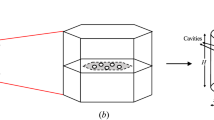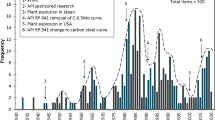Abstract
We present a numerical investigation of stress-assisted hydrogen diffusion in AISI 316L stainless steel by means of a diffusion software assembled to a finite-element elastoplastic code. Notched cylindrical bars with different radii of the notches are simulated and the effect of the stress field on the process of hydrogen transport is analyzed. The numerical results show that, regardless of the stress field, hydrogen penetration depths always remain smaller than 0.1 mm for simulated durations of the tests of about two months. If the effect of hydrogen damage is represented by a crack originating from the root of the notch, then we observe a decrease in the load-bearing capacity of the bars, although the contours of hydrogen concentration are remarkably similar to those found in bars without cracks.
Similar content being viewed by others
References
NET Status Report. Commission of the European Communities, Dec. 1985, Directorate General XII-Fusion Programme, Brussels (1985).
Y. Rosenthal, M. Mark-Markowitch, A. Stern and D. Eliezer, “Tensile flow and fracture behaviour of austenitic steels after thermal aging in a hydrogen atmosphere,”Mater. Sci. Eng.,67, 91–107 (1984).
E. Minkovitz and D. Eliezer, “Hydrogen-assisted cracking of sensitized 316L stainless steel,”J. Mater. Sci.,16, 2057–2511 (1981).
P. Rozenak and D. Eliezer, “Effects of metallurgical variables on hydrogen embrittlement in AISI-type 316, 321, and 324 stainless steel”,Mater. Sci. Eng.,61, 31–41 (1983).
P. Cotterill, “The hydrogen embrittlement of metals,” in:Progress in Materials Science, Pergamon Press, London (1961).
P. Bastien and P. Azou, “Influence de l'ecrouissage sur le frottement interieur du fer et de l'acier, chargés ou non en hydrogène,”Comptes Rendues Acad. Sci. Paris, 1845–1848 (1951).
G. M. Pressouyre and I. M. Bernstein, “A quantitative analysis of hydrogen trapping,”Met. Trans.,9A, 1571–1580 (1978).
M. R. Louthan Jr., and R. G. Derrick, “Hydrogen transport in austenitic stainless steel,”Corros. Sci.,15, 561–577 (1975).
P. Rozenak, I. M. Robertson, and H. K. Birnbaum, “HVEM studies of the effects of hydrogen on the deformation and fracture of AISI type 316 austenitic stainless steel,”Acta Met,38, 2031–2040 (1990).
A. Valiente, J. Toribio, R. Cortés and L. Caballero, “Tensile fracture of stainless steel notched bars under hydrogen charging,”J. Eng. Mater. Technol.,118, 186–191 (1996).
D. Hardie and D. Dong, “Effect of hydrogen on ductility of stable austenitic stainless steel,”Brit. Corros. J.,29, 156–160 (1994).
H. P. Van Leeuwen, “The kinetics of hydrogen embrittlement: a quantitative diffusion model,”Eng. Fract. Mech.,6, 141–161 (1974).
Additional information
Departamento de Ingenieria, Universidad Carlos III de Madrid; Escuela Politécnica Superior; Departamento de Ciencia de Materiales Escuela de Ingenieros de Caminos, Universidad Politécnica de Madrid; Departamento de Ciencia de Materiales, Universidad de la Coruña, Spain. Published in Fizyko-Khimichna Mekhanika Materialiv, Vol. 33, No. 4, pp. 87–96, July–August, 1997.
Rights and permissions
About this article
Cite this article
Cortés, R., Valiente, A., Ruiz, J. et al. Finite-element modeling of stress-assisted hydrogen diffusion in 316L stainless steel. Mater Sci 33, 491–503 (1997). https://doi.org/10.1007/BF02537546
Received:
Issue Date:
DOI: https://doi.org/10.1007/BF02537546




